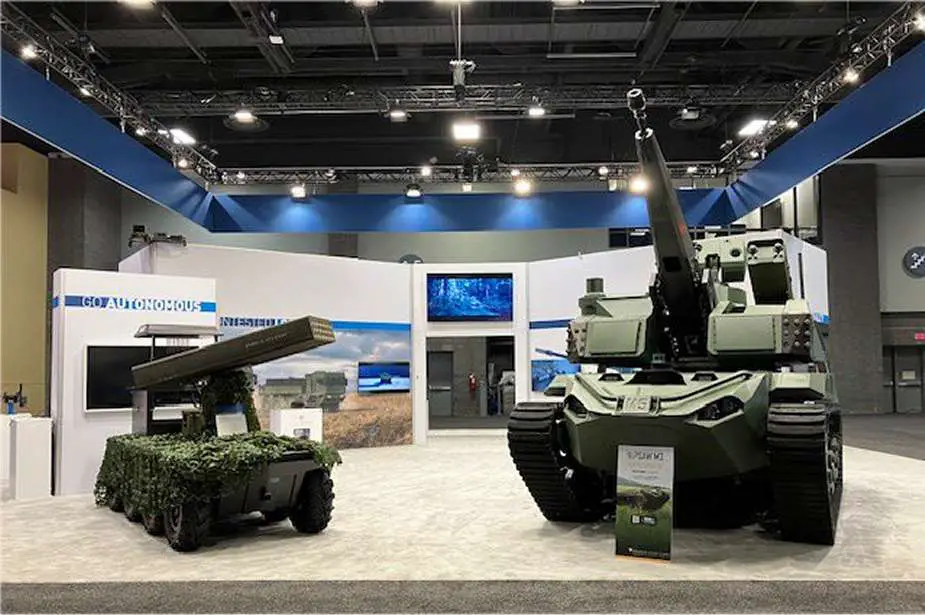Breaking news
Rheinmetall Defense and Textron Collaborate on New Robotic Counter-UAV Solution.
At AUSA 2023, Association of United States Army Conference and Exhibition, Rheinmetall Defense's American division showcased a groundbreaking robotic counter-UAS (Unmanned Aerial Systems C-UAS) solution. This innovation is built upon the Ripsaw M5 UGV (Unmanned Ground Vehicle), a product of the American firm Textron Systems, and is equipped with the Skyranger 30, touted as the globe's most sophisticated C-UAS turret.
Follow Army Recognition on Google News at this link

Rheinmetall Defense America displays its new robotic C-UAS Counter-Unmanned Aerial System at AUSA 2023 (Right Side), Association of United States Army Conference and Exhibition. (Picture source Rheinmetall Defense)
This merger of Rheinmetall's Skyranger turret with Textron Systems' Ripsaw M5 UGV has resulted in a system capable of safeguarding airspace and neutralizing UAS threats even in the harshest and most contested battlefields. Its capabilities extend to autonomous operations in frontline tactical scenarios.
Skyranger's integration with top-tier cannon systems ensures it can hold its own against multiple simultaneous threats. In collaboration with Textron’s M5, the Skyranger can be strategically positioned with ground troops or designated for the protection of crucial stationary assets. Its protective range includes defense against various aerial maneuvers such as loiter, pop-up, and dive attacks. The Skyranger 30 model is a testament to the advancements in C-UAS tech, combining comprehensive 360° surveillance of both air and ground with autonomous 30mm Oerlikon Revolver Gun®, Oerlikon AHEAD® airburst rounds, and short-range air defense missiles. The 30mm gun boasts an impressive firing rate of 1,250 rounds per minute. Paired with the airburst ammunition, it significantly increases the chances of intercepting even the tiniest drones.
Furthermore, Skyranger possesses the capability to autonomously create its local aerial view. Its open-architecture C2 system, Skymaster, along with IFF and data link, can be effortlessly merged with superior systems like FAADC2. As aerial threats continue to evolve, so does the Skyranger. With an available 35mm variant, the Skyranger lineup stands as the pinnacle of mobile defense against a spectrum of present and impending aerial challenges.
The Ripsaw M5 Unmanned Ground Vehicle (UGV) is a state-of-the-art robotic combat vehicle jointly developed by the American company Textron Systems and Howe & Howe Technologies. Its primary allure lies in its adaptability, offering a modular design that can be tailored with different payloads to suit diverse military needs. This flexibility means it can be outfitted with an array of sensors, weapons, and other essential systems.
One of its standout features is its armament capacity. Depending on its specific configuration, the Ripsaw M5 can be equipped with a broad spectrum of weapons, ranging from machine guns to anti-tank missiles. Complementing its weaponry is its suite of sensors, which can encompass everything from electro-optical and infrared cameras to advanced radar systems. These sensors play a pivotal role in reconnaissance, surveillance, and target acquisition missions.
Mobility is another hallmark of the Ripsaw M5. Designed for high-speed operations, it can adeptly navigate various terrains, making it a formidable asset in diverse operational environments. Beyond its remote operation capabilities, the vehicle boasts impressive autonomous functions. This allows it to undertake certain tasks and navigate terrains without the need for direct human oversight.
The Ripsaw M5's size and weight give it an edge in agility and maneuverability compared to its larger, manned counterparts. Moreover, its design can incorporate armor, providing it with protection against threats like small arms fire. The emergence of UGVs like the Ripsaw M5 underscores a significant shift in modern military strategy. There's a growing emphasis on harnessing the power of autonomous and robotic systems, not only to augment capabilities but also to minimize risks to human soldiers in the field.
Defense News October 2023


























